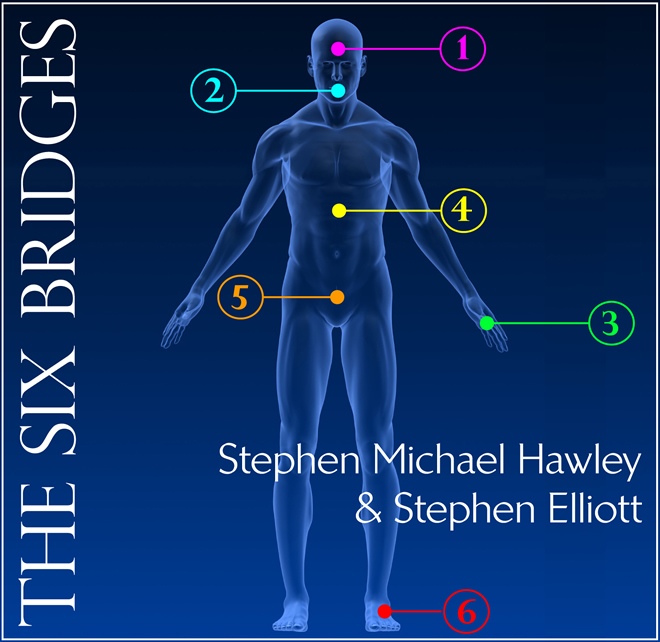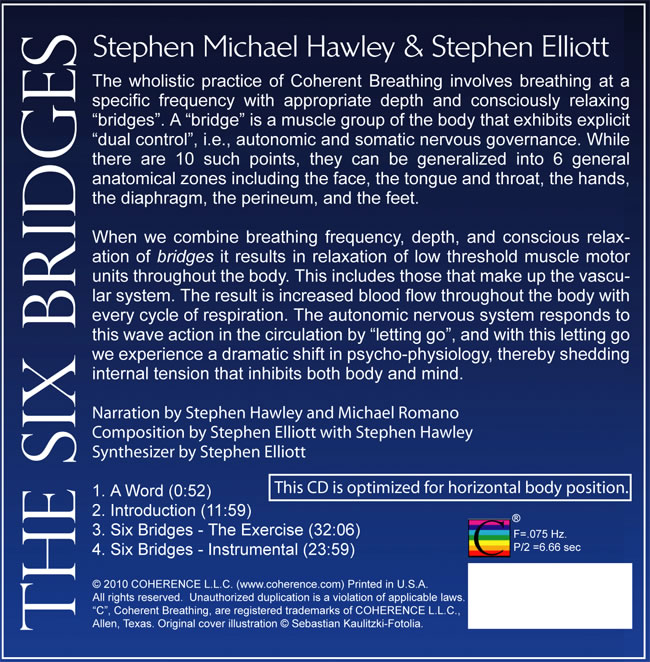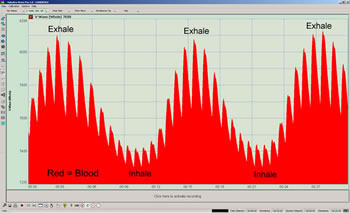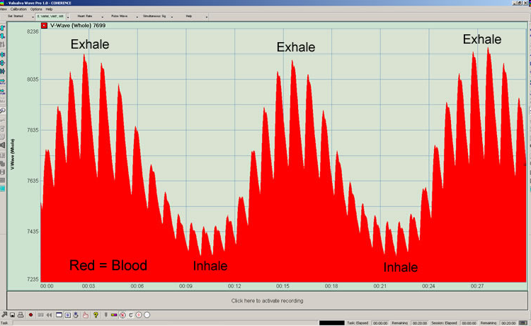THE SIX BRIDGES
Front Cover


ABOUT
Also see The Six Bridges, Body I/O, and Conscious Control Over Autonomic Function in BMED Report
Testimonials:
I recently purchased your “Six Bridges” and have been doing it for 21 days now, twice a day as instructed. I cannot tell you how remarkable I am experiencing it to be. I have a lifetime of heightened vigilance/anxiety, high stress levels, window of tolerance/resilience difficulties, etc. I practice yoga, somatic meditation, and yoga nidra to relax. However, since doing “Six Bridges” I feel as though for the first time in my life I am not only aware of the massive habitual tension I am holding, I find I am beginning to experience a sense that I am letting go profoundly, right down to the cellular level. So much so that I have found myself weeping with relief while doing the exercise. I wanted to share that I am most incredibly grateful for this gift… May 2nd, 2021.
The Six Bridges is the “progressive relaxation” method of Coherent Breathing developed by Stephen Elliott, developer of the Coherent Breathing method and principal author of The New Science Of Breath (2005). When we combine the practice of Coherent Breathing with the practice of the Six Bridges, muscles throughout the body gradually relax including those of the spine and the vascular system. A wave of blood issues from the lungs with each exhalation and returns to the lungs with each inhalation – Stephen Elliott and Dr. Bob Grove coined the name “Valsalva Wave” for this phenomenon. The graphic below depicts the Valsalva Wave captured with Valsalva Wave Pro. The slow wave is respiration; the faster wave riding atop is the heartbeat.
The Valvalva Wave
Knots in the muscles gradually disappear and “granthis” in the nervous system are unraveled. The body moves more freely, the mind is relieved of hindrances. When Coherent Breathing and the Six Bridges are combined with the practice of yoga and meditation, they take on a broad new dimension.
There are a number of therapeutic effects at work in the recording: a) Stephen Hawley’s narration employing subtle NLP techniques, b) the music which employs a certain disharmonic quality known to facilitate relaxation and relieve pain (Stephen Elliott has researched the ability of music to relieve pain and enhance performance for a decade), conscious relaxation of “bridges”, and of course, d) simultaneous Coherent Breathing. Many people find it very difficult to stay awake through the entire exercise, but with practice, staying awake is no longer difficult.
There are 12 anatomical zones of the body that possess the unique attribute of being explicitly controlled by both autonomic (subconscious) and somatic (conscious) nervous systems. We refer to these 12 points as “bridges”. They are the ciliary muscles of the eyes (ciliary muscles control the shape of the lens and hence, the focus of the eye), the external muscles of the eyes, the jaw, the lips, the tongue, the glottis, the hands, the diaphragm, the anal sphincter, the urethral sphincter, the vaginal sphincter, and the feet. They can be generalized into six: the face, the tongue and throat, the hands, the diaphrgam, the perineum, and the feet.
The ciliary muscles are the primary bridge that Les Fehmi’s Open Focus method employs.
There are a few things that bridges share in common. First, they all exhibit explicit “dual control”. Second, they all have a clearly defined open and closed state. Third, they play a predominant part in controlling the body’s interaction with the external environment. Hence, their “wiring” is extremely ancient and primordial.
Also see the June 2009, June 2010, July 2010, and July 2011, COHERENCE Newsletters…
Breathing (primarily a function of diaphragm movement) is probably a best example of what we mean by “dual control”. When we are not paying attention to our breathing, it continues anyway. However, when we wish, we have a very high degree of control over it, for example, we are able to hold our breath when we go under water, blow out the candles on a birthday cake, whistle a tune, or even more complex feats such as speaking or playing a musical instrument. And of course, if we are inclined, we are able to control our normal breathing to a very fine degree. This fine control of breath is a function of the somatic nervous system, a name given to the aspect of the central nervous system that affords conscious control of the body. Control of the diaphragm is a function of the phrenic nerve, the major nerve that provides both motor and sensory functions for the diaphragm. Therefore, it is the phrenic nerve that can ultimately be controlled both consciously and unconsciously by the brain. Great attention is given to the vagus nerve as it is indicative of autonomic state. One hardly ever hears about the phrenic nerve, the nervous function by which we are able to facilitate changes in the vagus nerve by breathing. This is a failure to see the root cause of vagal activity.
When we are not breathing consciously, breathing continues anyway – unconsciously. Unconscious breathing is a function of the autonomic or “automatic” nervous system. This is the name given to unconscious functioning of the central nervous system. The somatic and autonomic nervous systems are not separate physical systems but are simply names given to conscious vs. automatic control provided by the central nervous system (CNS). It is the “consciousness” behind the phrenic and vagus nerves that we are training with the practice of Coherent Breathing and The Six Bridges, such that it becomes innate, i.e., even when we are not aware of our breathing and “state”, once trained, our breathing continues to be slow, deep, and rhythmic and bridges remain relaxed. This is the goal.
The 12 “bridges” are those muscle groups of the body over which we have both very fine conscious and very fine unconscious control. The fine conscious control we have is primarily a function of use. At infancy, we have little conscious control over the body in general, but as we age and interact with the world, we develop a very fine degree of control, for example, the hands typing on a keyboard as I am doing now as I write this, or the breath playing a musical instrument. And as we know, the hands in particular can become very skilled at doing things. This skill is a function of the neural network that is built and strengthened via use.
Use of the hands results in a widening of the communication channel between the hands and the central nervous system – this is a concept. The same can be said for all of the “bridges”, and probably for any body part to a degree, if we were to use it very consciously to do something exacting over a long period of time. As the neural network is reinforced, our awareness of the body aspect grows. Where the hands are concerned, our hands have more feeling. Where the breath is concerned, there is more sensation.
This “channel” is bi-directional, one direction of communication is from CNS to hands, and the other is from hands to CNS – motor and sensory. This bidirectionality facilitates real time control of movement.
The Six Bridges takes advantage of this. Here is an example. Please follow along.
1) Place your hands in a comfortable position, perhaps relaxing them on your thighs.
2) Now, close your eyes and sense your hands. Feel them as completely as you can. Sense the outside and the inside. Feel the palms and the back, the skin and the fingernails.
3) Now, with this heightened sense of the hands, inhale and as you exhale, relax them as completely as possible. Inhale, then as you exhale, let them go, “letting all the muscles go from the bone”. Try it a few more times. You may wish to employ the mantra “Sah” as you exhale as this heightens the sensation.
During the practice of The Six Bridges its important to remember this “definition” of relaxation. First place the mind on the bridge, for example the hands, second we feel the area a much as we can, third we exhale and “let it go”, letting all the muscles go from the bone. Give it up to gravity! There is a certain sensation that comes with this…. Its as though the muscles cease to grip the bone, expanding slightly, the energy being set free. We are able to sense the force of gravity.
What we’re really doing when we “let go” is quieting the nervous system associated with the hands, in effect reducing the ambient noise level in the central nervous system associated with the hands. We’re using our heightened awareness of them to sense their state of excitation, then we are actively reducing their state of excitation. This is real biofeedback!
With continued practice, the ambient noise in the CNS is reduced. And its not just reduced in the hands, its reduced everywhere in the CNS. All bridges work in this same way, although with varying affect.
Its interesting to note that the hands cannot be relaxed without the arms being relaxed. The same is true of the feet and the legs. And the arms cannot be relaxed unless the face is relaxed. Likewise, the legs cannot be relaxed unless the perineum is relaxed. So, there is a pretty clear nervous system relationship between these points – as one would expect.
Finally, none of the points will relax if the diaphragm is not relaxed and operating within a viable range of motion, where the goal is 40-60% of its range. To understand why, please see this tutorial on Coherent Breathing.
A goal is to become familiar with all of the bridges, such that we are able to monitor and manage their status on an ongoing basis – as their status is an indicator of overall autonomic state. We like to say that “bridges act as knobs and levers that afford us conscious control over what is otherwise subconscious”.
Where Six Bridges Can Help
The Six Bridges is a progressive relaxation exercise that allows one to overcome automatic responses to stress and it’s result – tension.
It is an integral part of the “Coherent Breathing System”.
The Six Bridges is practiced in a horizontal body position and works from the head down – while breathing “coherently”, so Coherent Breathing is a requisite.
The reason Coherent Breathing is a requisite is that the autonomic nervous system will not let the body relax if breathing is not relatively slow, deep, and rhythmic.
Eventually, one learns how to “let go” of the bridges with every exhalation whether in a horizontal or vertical body position.
With this, both breathing “coherently” and letting go of tension with every exhalation becomes an integral part of daily existence.
When bridges are tense our “shields are up”. When our shields are up we are isolated from the world, and with this isolation our senses are cut off. We are in a defensive state and are unable to perceive. Our intuition is dulled. Subtle communication with others is diminished, and with this the ability to connect, understand, and empathize.
The goal of the practice is that we are able to live life with “shields down”, open to the world with heightened perception. With daily practice we shed insult and injury such that it doesn’t accumulate in the body/mind ultimately resulting in stress and tension, negative rumination being an indication that the autonomic nervous system is erring on the side of sympathetic bias – where we prefer to persist in a state of balance.
This balance can be detected objectively via multiple forms of instrumentation including Electroencephalograpy, Electromyography, Electrocardiography, Galvanic Skin Response, a.k.a. Electrodermal Response, Heart Rate Variability, and body current to Earth – when we are breathing deeply and the body is deeply relaxed, current between the body and planet Earth increases.
Back Cover


About the "Valsalva Wave"
- The wave to the left is the “Valsalva Wave” as seen at the earlobe.
- It is detected plethysmographically with Valsalva Wave Pro, a patented COHERENCE biofeedback instrument.
- It occurs as a function of rhythmic diaphragm motion, diaphragm motion facilitating the “thoracic pump” which moves both blood and air in and out of the lungs with each inhalation and exhalation, respectively.
- The wave rises with exhalation and falls with inhalation.
- The wave consists of 2 components: a) the heart beat which rides atop, and b) the respiratory component which exists below.
- When one is not breathing with significant depth there is no wave, just a steady heart beat.
